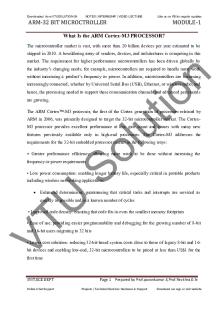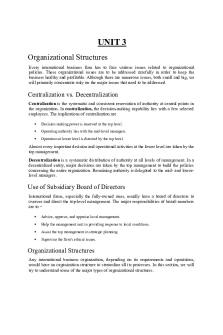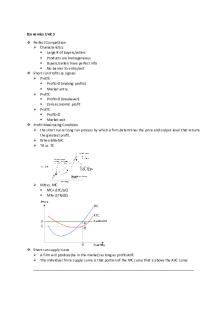Embedded Systems Notes - Unit - 3 PDF

| Title | Embedded Systems Notes - Unit - 3 |
|---|---|
| Course | Embedded system |
| Institution | Guru Gobind Singh Indraprastha University |
| Pages | 11 |
| File Size | 308.3 KB |
| File Type | |
| Total Downloads | 26 |
| Total Views | 157 |
Summary
just study these notes . all of the notes are there for exam....
Description
Embedded Systems By Chandra Sekhar G. Assistant Professor Electronics and Communication Engineering Dept. Bharati Vidyapeeth’s College of Engineering, New Delhi
UNIT - III
Embedded Software Concept of Real Time Systems Software Quality Measurement Compilers for Embedded System.
Note: Prerequisites: Clear Conceptual knowledge in Microprocessors, Microcontrollers and their Functional Units. This Notes is prepared mostly using NPTEL Videos of Embedded Systems, IIT Delhi. Some concepts are taken from Internet. This notes is prepared to complete the syllabus in the given number of lectures and in the exam point of view. For more and detailed theory go through the text book Computers as components: Principles of Embedded Computing System Design, Wayne Wolf, Morgan Kaufman Publication, 2000.
Software for Embedded Systems Now, we will study the software for embedded Systems. And in particular, the software environment and the practices to be followed for developing software’s for Embedded Applications.
Embedded software****
Program that controls an embedded system. Program is a piece of code written to perform a task. Written specifically for the particular hardware that it runs on. Loaded in the microcontroller which then takes care of all the operations that are running. Tools need for developing an embedded software include editor, compiler, assembler and debugger. Software interacts with physical world Therefore takes time. Consumes power. It does not terminate Embedded software examples Hidden in watches, VCR’s, cellular phones, toasters etc. Guides missiles, Controls satellites Used in medical instruments. So embedded software, a typically hidden in watches, VCR’s, cellular phones, toasters. And, not like a general purpose software. It guides missals, controls satellites and also used in medical instruments. So obviously, this application scenario makes embedded software special and different from that of standard desktop software. We have varying requirements and different characteristics of hardware platform for embedded systems. In a way, the software for embedded systems interacts with physical world with sensors and actuators. It therefore, definitely takes time. So, there is an issue of time consume by the software in relation to the timings of the external events. It also consumes power. So, we have to think in terms of designing software which is power efficient. The last thing is that it does not terminate. Unlike standard programs, where we expect them to terminate, with an infinite number of steps these programs typically do not terminate. Software Complexity Embedded software can be very simple, run on an 8-bit microcontroller with just a few kilobytes of memory, Ex: Controlling lighting in homes. Complex embedded software - in aircraft avionics systems, in missile guidance systems, in navigation systems Depends on varying requirements and hardware platforms Requirements of software for embedded System Reliability: Should be Reliable, because human intervention is not possible for error handling. They are expected to run without human intervention to long period. Cost: They should be cost effective. Power : Low power consumption, Memory: They should make efficient use of memory, because the memory cannot be unbounded. Performance requirement: The most important performance requirement is that of timeliness. Embedded software is similar to firmware, as they usually serve the same function. The latter, however, is a special type of embedded software that is written in non-volatile memory (such as ROM or EPROM), which cannot easily be modified — hence the name "firm" — and is used primarily for running or booting up the device. In contrast, embedded software is used for the overall operation of the device. The main difference between embedded software and application software is that the former is usually tied to a specific device, serving as the OS itself, with restrictions tied to that device’s specifications, so updates and Embedded Systems Chandra Sekhar G. Assist. Professor ECE Bharati Vidyapeeth’s College of Engg., New Delhi.
additions are strictly controlled, whereas application software provides the functionality in a computer and runs on top of an actual full OS, so it has fewer restrictions in terms of resources. Embedded System Software An embedded system needs software to drive it. Figure below shows four typical software components required to control an embedded device. Each software component in the stack uses a higher level of abstraction to separate the code from the hardware device.
The initialization code is the first code executed on the board and is specific to a particular target or group of targets. It sets up the minimum parts of the board before handing control over to the operating system. The operating system provides an infrastructure to control applications and manage hardware system resources. Many embedded systems do not require a full operating system but merely a simple task scheduler that is either event or poll driven. The device drivers are the third component shown in Figure 1.4. They provide a consistent software interface to the peripherals on the hardware device. Finally, an application performs one of the tasks required for a device. For example, a mobile phone might have a diary application. There may be multiple applications running on the same device, controlled by the operating system. The software components can run from ROM or RAM. ROM code that is fixed on the device (for example, the initialization code) is called firmware.
Features of Embedded Software**** Timeliness Computation takes time Even infinitely fast computer embedded software needs to deal with time because the physical processes with which it interacts evolves over time. Satisfy timing constraints. So, this timing conditions and constraints are to be followed. Performance gain due to the use of elaborate caching schemes, speculative instruction execution and branch prediction are avoided in micro-controllers and DSP’s since they compromise system efficiency and reliability. Concurrency Embedded systems interact with the physical world where multiple things happen at once. Embedded Systems need to react stimulus from a network of and variety of sensors and retain control over actuators. And so, the processing should be concurrent. Liveliness – Program must not terminate or block waiting for events that will never occur The whole system would basically fail. Watchdog timer - ensure liveliness. Heterogeneity – Software must be able to hand the Different computational styles (access phone book, handle call) and implement technologies. Interact with events occurring in the external world may be of different types. They may be regular, they may be irregular Irregularly in time (alarms, user commands, sensor triggers, etc.) Regularly in time (sampled sensors data and actuator control signals) Reactivity – The reactivity means reacting to the external environment. React continuously to the environment at the speed of the environment. If it cannot react at the speed of the environment then the whole sequence of the plans gets diminished. Embedded Systems Chandra Sekhar G. Assist. Professor ECE Bharati Vidyapeeth’s College of Engg., New Delhi.
And since, it is reacting to the external environment; obviously, there would be bounds, bounds in the response time. So, reactivity is an important issue with embedded Systems. They should be also safety critical, because in many cases there handling critical equipment a critical machinery. So, they cannot fail arbitrarily or fail without giving priority signals such that a catastrophe lockers. So, they have to be there have to be built in safety critical features with the software.
Interfaces – Components combined according to the interface based upon static behavior Processes as components in Embedded Systems A speech coder on the cellular phone transforms unbounded input data to unbounded output data How to package speech coder commercially available in a way that can safely share system resources with other computations?
Real – Time Systems**** Response Time: The time between presentations of a set of inputs to the system and realization of the required behavior, including availability of associated outputs, is called the response time of the system. So, when there is an external signal coming in, corresponding to the characteristics of the external signal there would be bound on the response time and that leads to the formal definition of real time systems. A real time system is a system that must satisfy explicit bounded response time constraints or risk severe consequences including failure. But, one point also to be noted that all embedded Systems are not necessarily real time systems. There as some systems which are definitely real time and for them this bound is critical. Classification of Real time systems: This real time systems can be categorized further into soft real time systems and hard real time systems as well as firm real time systems. A soft real time system is one in which performance is degraded. But, not destroyed by failure to meet response time constraints. It may be an automatic teller machine. There may be delay in delivery of the cash but, the delay is not critical. This is true for a typical DVD player as well when it is decompressing a video frame for play back. In fact in a way, you can consider that all systems or all software for that matter in some other soft real time. Because, you would not like to use to what processor which would give you response time of a 5 minutes. So, there is also a kind of minimum expectations for the interactive systems. A hard real time system is one in which failure to meet a single deadline may lead to complete and catastrophic system failure. So, example is say Avionics weapon delivery system. Because, after the decided presses a button to release a weapon from that point to the actual delivery should be bounded. Otherwise the target would be missed. So, the whole purpose of releasing the weapon is lost. So, this is a hard real time system. The other example could be control system in a nuclear power plant evolved has to be closed within a definite bound otherwise there may be an explosion. A firm real time system is one in which a few missed deadlines will not lead to a total failure. But, missing more than a few may lead to complete and catastrophic failure. So, it is somewhere between hard and soft real time systems. An example is a navigation controller for a robot weed killer. This is slightly different kind of an example. So, if a robot weed killer is moving around there will be deadlines corresponding to its navigation. It can miss few deadlines but, if it continuous to miss that meet miss the deadlines, what can happen. It may actually destroy the good scrapes instead of the weed. So, the effect can be really catastrophic. Embedded Systems Chandra Sekhar G. Assist. Professor ECE Bharati Vidyapeeth’s College of Engg., New Delhi.
Software Quality Measurement***** Now, how do you measure quality of a software? Dynamic efficiency: Number of CPU cycles required for execution of the software. Static efficiency: Number of bytes required i.e. the RAM size the ROM size. The RAM would accommodate the Global variables and the runtime stack as well as the heat. The ROM size would determine the fixed constants on the program code. ROM we are using in a generic sense. It can be EPROM E square PROM. It can be even flash. And the power consumption is another issue. Correctness: Logical correctness as well as temporal correctness and these two a primarily for the purpose of maintaining and reusing the software. Easy to Understand Easy to change: Flexibly and Maintainability So, Dynamic efficiency, Static efficiency and power consumption – these three are very important parameters to measure quality of a software targeted for embedded Application. The other issues the obvious is correctness - logical correctness as well as temporal correctness and these two a primarily for the purpose of maintaining and reusing the software. So, it should be easy to understand it should be easy to change. So, ensure flexibility and maintainability. These are more from the classical software engineering perspective.
Embedded Software Design Process
The different steps in an embedded software design process include the following. Determine the Requirements Functional and nonfunctional Multimode or multifunctional system Size, cost, weight, etc. Choosing the hardware components Application specific hardware External interfaces Input and output devices Design the System Architecture The architecture of an embedded system depends on, Whether the system is real time Whether operating system needs to be embedded Embedded Systems Chandra Sekhar G. Assist. Professor ECE Bharati Vidyapeeth’s College of Engg., New Delhi.
Cost, size, power consumption, etc. Select the OS If operating system we can select, Real-time operating systems like RTLinux, VX works, pSOS, QNX, VRTX, etc. Nonreal operating systems like Windows CE, embedded Windows XP, etc. Choose the Processor The following processors can be used in the development of an embedded system Microprocessors-8085, 8086, Pentium Microcontrollers-PIC, MCS-51, MSP-430, AVR Digital signal processor- dsPIC, Sharp, Blackfin,Tigersharc Choose the Development Platform The development platforms of an embedded systems include the following The hardware platform The programming language The operating system The development tools Code the Applications and Optimize The coding of an embedded system can be done by using the following programming languages. Assembly language C language Object oriented languages like C++, Java, etc. Optimizing the code Verify the Software on the Host System Compile and assemble the source code into object file Use a simulator to simulate the working of the system Verify the Software on the Target System Download the program using a programmer device Use an Emulator or on chip debugging tools to verify the software So, what is a process of developing software for an embedded System? To be very similar to that of general software, but there may be and there will be some differences. First you; obviously, determine the requirements; you design the system architecture, the software system architecture. With respect to the requirements of the system Architecture, you select Operating System. It is not that for all embedded Systems you really require an OS. If you really require an OS, what kind of characteristics, the way should satisfy. Then, you choose the development platform because, the development platform is in many ways depended on the OS that we choose. Then, you obviously, code the application. Optimize the code, according to the requirement you should optimize the code. So that, you can meet the quality measures, verify the software in the host system. It may be simple simulation and verify the software on the target system.
Choice of Programming languages Assembly language Processor dependent Efficient Difficult to maintain and write large programs High level language Portability Easy software development So, what are the different choices of programming languages that you can use for developing the software? It may be assembly language; it may be high level language. If you are using assembly language, assembly languages obviously, a processor dependent and assembly language program can be really efficient. Because, you can exploit the architectural features of the target processor directly. But, it is difficult to maintain and write large programs. Because then, it becomes complex, because the number of instructions that would be required Embedded Systems Chandra Sekhar G. Assist. Professor ECE Bharati Vidyapeeth’s College of Engg., New Delhi.
will be much more. As a number of instructions increases the probability of bugs coming into the core also increases. At the same time, the other problem is portability. Because, if you decide to change the processor. Then, your software has to be completely changed. High level language; obviously, ensures portability and easy software development. Because, the number of instructions, the number lines of core that you need to handle for a given task would be much smaller. And the compiler performs the job of translation. But, compiler may not have the capability to optimize the target core with reference to the target architecture.
Programmer’s view: So, if you look at the basic programmers view, what we find today? The most development is done today using structured languages that is high level languages. But, some assembly level programming may still be necessary. In particular the device drivers, the portion of program that communicates with and/or controls (drives) another device, which is connected with your basic micro controller for those device interfacing applications. You still need to do assembly language programming. Because, you have to take care of very strict timing constraints and may involve extensive bit manipulation. So, for that purpose assembly language program is pretty efficient.
Build Process So therefore, the software development goes through what is known as a built process. Now, when target platform is known, tools can exploit features of the hardware on the OS in the building process. But, it is not always that you can make assumptions about the target i.e. Embedded software development tools can rarely make assumptions about the target. So, in that condition user needs to provide information about the target. So, the build environments which are targeted for these kinds of developments always have provision for putting in these kind of parameters from the uses.
Compiling: Parsing, Semantic Analysis and Object Code Generation The most important aspect of the component of the build processor is compile. And the compiling is important here that aspect of compiling is important for the object code generation and what we call code optimization. Because, the object code has to be optimize with respect to the target architecture. And, you need to optimize also the code that you are generating. You cannot really translate straight away a high level language code in to the target machine instructions. There has to be some kind of the core transformations if we want optimal exploit. So, the register set of the processors. So the aspect of compiler design and implementation has tremendous relevance, an importance for embedded Systems. Then, the other important issue is that you actually use cross compilers or cross assemblers. This compilers or assemblers actually run on host which is different from the target. Typically, a standard compiler or C compiler in a Linux machine, you will run and generate the code for the target architecture itself. The target architecture may be the Pentium itself. But, when you are using a across compiler it may run on a Linux machine. But, it would generate the core for say ARM processors.
Object Files Now, what does compilation rate? Compilation rate object files. Contents of object file can be thought of as a very large flexible data structure which contains instructions and the data resulting from the translation process. So, object file which is generated in the host system is not definitely the executable image. In standard formats COFF - Common Object File Format ELF - Extended Linker Formats. Why they come in standard form? Now, these object files can be used with the linkers as the software tools, which are targeted for the specific platforms for generating the executable image. Object files typically contains Code blocks which are text block, which we refer to a text block And initialized or even un initialized global variables, which is a data block. Embedded Systems Chandra Sekhar G. Assist. Professor ECE Bharati Vidyapeeth’s College of Engg., New Delhi.
...
Similar Free PDFs

Embedded Systems Notes - Unit - 3
- 11 Pages

Embedded Systems Unit - 1
- 99 Pages

Micro C - embedded systems notes
- 4 Pages

embedded systems assignment
- 8 Pages

ARM Microcontroller & Embedded Systems
- 141 Pages

Embedded-Systems-Design
- 110 Pages

Unit 3 Textbook Notes
- 29 Pages

Sdm-unit 3 - notes
- 35 Pages

UE18CS313 UNIT 3 Notes
- 47 Pages

HHD UNIT 3 - notes
- 43 Pages

Unit 3 Notes
- 7 Pages

Unit-3-Notes - Lecture notes 3
- 12 Pages
Popular Institutions
- Tinajero National High School - Annex
- Politeknik Caltex Riau
- Yokohama City University
- SGT University
- University of Al-Qadisiyah
- Divine Word College of Vigan
- Techniek College Rotterdam
- Universidade de Santiago
- Universiti Teknologi MARA Cawangan Johor Kampus Pasir Gudang
- Poltekkes Kemenkes Yogyakarta
- Baguio City National High School
- Colegio san marcos
- preparatoria uno
- Centro de Bachillerato Tecnológico Industrial y de Servicios No. 107
- Dalian Maritime University
- Quang Trung Secondary School
- Colegio Tecnológico en Informática
- Corporación Regional de Educación Superior
- Grupo CEDVA
- Dar Al Uloom University
- Centro de Estudios Preuniversitarios de la Universidad Nacional de Ingeniería
- 上智大学
- Aakash International School, Nuna Majara
- San Felipe Neri Catholic School
- Kang Chiao International School - New Taipei City
- Misamis Occidental National High School
- Institución Educativa Escuela Normal Juan Ladrilleros
- Kolehiyo ng Pantukan
- Batanes State College
- Instituto Continental
- Sekolah Menengah Kejuruan Kesehatan Kaltara (Tarakan)
- Colegio de La Inmaculada Concepcion - Cebu



